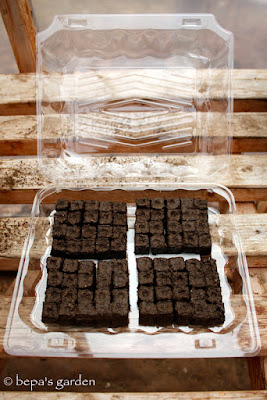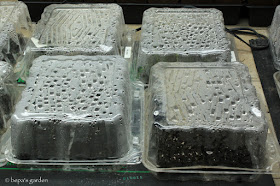 |
| Seedling in 3/4" soil block. |
Friday afternoon I finally took some time off from working to get my seeds started.
I started leeks, kale, eggplant, onions, lettuce, spinach, beets, lavender, marjoram, sage, parsley, thyme, rosemary, oregano and petunias, totaling 800 plants. This year I am not only starting seeds for our own garden, but also for the school garden and for a seedling sale to raise money for the school garden, so this is about a third of what I am planning to start.
Several years ago I started using soil blocks instead of seed starting trays to start all my seeds. I have had much better results with this method and it is much cheaper because I don't have to buy starting trays or peat pots each year.
To make soil blocks you need special tools called a soil block maker.
The soil block makers come in different sizes, 3/4", 1-1/2", 2" and 4". The smaller 3/4" blocks are perfect for starting small seeds like lettuce, kale, herbs, etc, and the larger blocks work well for starting larger seeds like cucumber and squash. Soil block makers are available from several gardening stores such as Johnny's and are reasonably priced.
Johnny's also has a video showing how to use a soil block maker.
There are soil mixes available specifically for use with soil block makers which I have used in the past, but I have had much better results mixing my own using my own compost.
The first thing I do is sift some of my compost with a fine screen to take out most of the stones, sticks and leaves.
After sifting, I am left with very fine compost and a little soil. The compost will absorb moisture, help hold the block together and supply nutrients to the emerging seed.
The next step it to mix in a little water with the sifted compost. You don't want a soaking wet mix, so just add enough water to make a cement like mixture. If you take a handful of mix and squeeze it in your hand you want it to stick together without a lot of water coming out of it.
Once you have your mix ready, you will use your soil block maker to make your blocks.
 |
| 3/4" soil block maker - makes 20 blocks. |
You simply push the maker into the mix, push it around to fill it with soil, and then press it out into your trays using the handle. The soil block maker creates a little dimple in the center of the block for the seed. I simply place a seed in the center of each block and tap it in using my small dibble, making sure it has good contact with the soil.
I use old lettuce containers from the grocery store. They are the perfect size, they hold 80 3/4" blocks each and make little greenhouses when closed.
I put them directly on my heating mats and keep them closed until the seeds start to germinate and the leaves start to form.
The concept behind using soil blocks is simple.
The seeds are planted in the shallow dimple and are not covered by soil. Seeds started this way germinate faster because they have plenty of oxygen. Once the seedlings started in the smaller blocks have their first true leave, they are "blocked up" to the next larger size soil block. The 1-1/2 and 2" block makers form a 3/4" square hole in the block, allowing you to just pop in the 3/4" blocked seedling without disturbing the roots.
 |
| Cucumber seedling in 3/4" soil block. |
 |
| 2" soil blocks with 3/4" dimples. |
The
roots will continue grow to the outer walls of the block and then stop. When the
roots reach the edge they have ample air, water and nutrients
so they will now send their energy into growing the plant which results in
healthier seedlings. The plants will not become root bound like they do
when using peat pots or plastic pots.
 |
| Basil seedling in 2" soil block. Notice how root growth stops at edge of block. |
When planting the seedlings into the garden you simply make a hole large enough to fit the soil block and plant it into the garden. Planting this way doesn't cause stress to the plants because you are never disturbing the roots. By using soil blocks to start my seeds I have much higher germination rates, faster germination and healthier plants.
These seeds were started Friday afternoon and Saturday morning they have already begun to germinate!
Shared at:
Deborah Jean's Dandelion House
Tilly's Nest
The Backyard Farming Connection
Eat, Make, Grow
 |
| Kale seeds beginning to germinate. |
 |
| Lettuce seeds emerging. |
 |
| Lettuce in 2" soil blocks (photo taken last spring) |
Shared at:
Deborah Jean's Dandelion HouseTilly's Nest
The Backyard Farming Connection
Eat, Make, Grow
 |
| Bert and Ernie - just a year ago! |









Visiting & Following because of The Great Blog Train Blog Hop! I love gardening!!
ReplyDeleteHelen
Blue Eyed Beauty Blog
Welcome and thanks for following!
Delete~Rob
Thanks for sharing this...a great explanation about how they work too. I was just reading about them the other day. :)
ReplyDeleteThanks. The concept of soil blocks dates back over 2000 years when the Aztec's used to use cubes of mud to grow seedlings!
DeleteThese look great! I still use little coir pots to grow my seeds. But if I sowed as many seeds as you do, I'd soil block, too. :o)
ReplyDeleteThe amount of seeds I start each year seems to be "growing" (pun intended). Now that I am starting flowers as well as vegetables and herbs I need a larger greenhouse!
Delete~Rob
I really think this is one of the best gardening blogs around.. happened upon it my accident and have loved receiving the emails. Beautiful photography, too. Well done!
ReplyDeleteThanks so much!
Delete~Rob
Brilliant! So clear. Love your site!
ReplyDeleteHow awesome! I had no idea that there was a tool to make soil blocks. Seems like it would be extremely useful. I'll keep this in mind as we start our seeds (hopefully soon). Love that last shot of Bert & Ernie :)
ReplyDeleteI can't believe they were so small a year ago! I love having them in the garden!
Delete~Rob
I love my soil block maker! I also love your little greenhouses. This is what I need to do with mine instead of using the trays.
ReplyDeleteThe lettuce containers really do work well. I would like to just start them out in the greenhouse on heating mats, but I haven't run power out there yet. Maybe next year!
Delete~Rob
Just hopped here from Eat Make Grow. Great, informative post! We first learned about soil blocks while visiting the greenhouses of Heritage Prairie Farm (Elburn, IL), not far our neck of the woods, and I've been wondering about using them ourselves. You have illustrated the whole deal very nicely here.
ReplyDeleteThanks for stopping by! I have had great success using soil blocks. In an upcoming post I'll be talking about "blocking up" the seedlings.
Delete~Rob
Rob, What a wonderful tutorial and explanation of how to use soil blocks for seed starting. You've sold me! My greenhouse has been damaged by the storms we've had and is leaning to one side right now...and we are getting more snow today... seeing your little sprouts give me home... spring must be on the way!
ReplyDeleteThanks Deb, sorry to hear about your greenhouse. Luckily mine has survived Super Storm Sandy and the last nor'easter without any damage. We are getting snow today as well, but I am still out there starting my peppers!
DeleteI had never heard of soil blocks until I read your blog and I am hopelessly intrigued! I love that you don't have to disturb the root ball in transplanting. I will definitely be looking into this method for the future. Thanks for such a great explanation and photos!
ReplyDeleteThanks for reading!
DeleteCan you share your soil block mix recipe?
ReplyDeleteSure, I just use my own compost which consists of leaves, grass clippings, kitchen scraps and garden debris composted down to a crumbly mixture and screened with a 1/4" mesh. There are recipes for block mixes that include peat moss, lime, sand, fertilizer, soil and compost, but I found that I get really good results with my own compost.
Delete